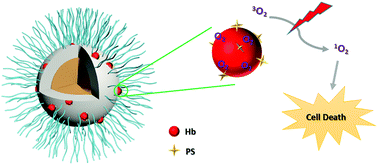A photosensitizer loaded hemoglobin–polymer conjugate as a nanocarrier for enhanced photodynamic therapy†
Abstract
Photodynamic therapy (PDT) has emerged as a promising therapeutic option for various cancers. During the photosensitizer-mediated PDT procedure, oxygen is activated as a reactive oxygen species (ROS) upon light irradiation to induce vascular damage and cancer cell death directly. However, PDT efficiency can be seriously reduced in the hypoxic environment of the tumour. Even worse, the oxygen consumption of PDT aggravates the hypoxia, which leads to further PDT inefficiency and other negative consequences. Herein, a new kind of hemoglobin–polymer conjugate (HbTcMs) was prepared as the carrier for both oxygen and the photosensitizer to enhance photodynamic therapy. The conjugated Hb exhibited an improved tolerance to the oxidation and trypsin digestion while retaining its O2 binding capacity compared with free Hb. The HbTcMs conjugate showed little toxicity in the dark and could be effectively internalized by 4T1 cells. More importantly, the HbTcMs conjugate could readily produce singlet oxygen (1O2) and kill 4T1 cells in vitro under irradiation, exerting better phototoxicity with the oxygen supply of Hb. Therefore, it is expected that the HbTcMs conjugate can be a potential oxygen carrier for application in photodynamic therapy.



 Please wait while we load your content...
Please wait while we load your content...